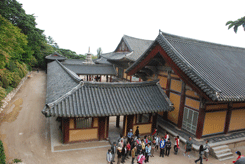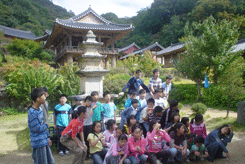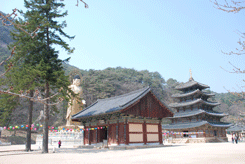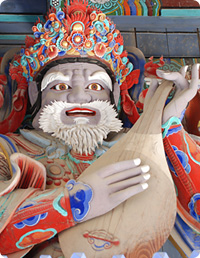Temples
 |
 |
 |
Buddhism is not to attain anything per say, but to pursue the true nature of identity. A common Buddhist quote is that, "we can see the universe as it is and our true nature when delusion and defilements disappear.'' And so is the goal of Buddhism; to see things clearly, as they are. Buddhist images that are portrayed in numerous temples, mountains and valleys across Korea represent a devout spiritualism which inspired artists for centuries. The earliest examples of sculpture as it is generally known are some rock carvings. In the bronze ages, bronze, earthenware and clay figurines were produced in abundance but it was not until the introduction of Buddhism that sculpture in Korea began to develop in both quantity and quality.
Goguryeo Period (BC 37- AD 668)
Mahayana Buddhism was started from the reflection on the complicated and differing sectarian interpretations of Buddhist doctrine a century after the Buddha's death in India and is considered a practical religious movement as practiced in Tibet , China , Korea and Japan . Buddhist images were brought into the country when Buddhism was introduced to Goguryeo in AD 372. It is believed to have been some decades after that before Korean artisans began to make Buddhist images. Although there is no tangible proof, it is quite plausible that Goguryeo was the earliest of the three kingdoms to make Buddhist images as it was the first to be exposed to the religion. A gilt-bronze image of a seated Buddha of the 4th century was recently found near the Han river in Seoul, which was part of the Baekje kingdom, but it is believed to be a Chinese import as its style strongly suggests the Northern Wei sculpture. Only after the 6th century, early Korean Buddha images were created with distinctive inscriptions of date. The Goguryeo Buddhas have lean elongated faces, prominent Usnisas, a protuberance on top of the head symbolic of supreme wisdom which is one of the identifying marks of a Buddha, on mostly shaven heads, rigid cylindrical bodies draped by thick robes that have fish-tail folds at the hem on both sides and hands that are unproportionately large. The boat-shaped nimbuses encircle not only the heads but most of the length of the bodies and are decorated with crude but meticulously depicted flames. The pedestals, which are cylindrical, are finished with lotus petals carved with a masculine touch. Embodying these characteristics best is a gilt-bronze standing Buddha with the inscription Yongga seventh year which corresponds with 537 AD. The archaic smile on its elongated face, the rigid body draped with a thick robe and the hem of the robe that is pointed like feathers at the sides all work together to produce a spiritual quality. A gilt-bronze Buddhist triad with the inscription of Gyemi year as its casting date also shows the same characteristics. A great number of clay Buddhas of the same style found in the Pyeongannamdo province are believed to have been made in the mid sixth century, though they are without inscribed dates. As Goguryeo's artisans improved and Buddhism became firmly established, sculpture experienced many stylistic changes and a truly Goguryeo style developed around 560
Baekje Period (BC 8 - AD 660)
Buddhism was introduced to Baekje in 384. The production of Buddhist images in Baekje began in the 5th century. The earliest examples date from the 6th century and include a stone triad and some clay images from the Jeonglimsa temple, a gilt-bronze standing Buddha from the site of the Powonsa temple, some Buddhas carved around a boulder in Yesan, and a gilt-bronze Buddha with the name Chong Chiwon inscribed on it. Characteristics unique to Baekje sculpture are clearly evident in all the Buddhist images of the late 6th century including an agalmatolite seated Buddha, a gilt-bronze bodhisattva from Gunsuri, and stone relieves of Buddhist triads in Seosan and Taean. Whatever the influence were, Baekje Buddhas of the time are characterized by warm human attributes. The smaller usnisa, the stately but relaxed body, the voluminous curvature under the thick rove, of the robe of the bodhisattva that crosses each other in the shape of an X, the simple but refined rendering of the lotus petals of the pedestals are definitely local traits Baekje artisans developed from the Chinese styles of the late Northern Wei, Chi and Chou. Baekje Buddha is inimitably unique with a benevolent smile that graces the round pleasant face, which is labeled the Baekje smile. The modeling of the bodies became much fuller and some bodhisattvas were depicted slightly twisted with S-shaped postures rather than in upright, static positions. These traits are best illustrated by a gilt-bronze standing bodhisattva from Gyuam in Buyeo, and a seated stone Sakyamuni in Yeongdong-ri, Iksan. Baekje sculpture can be summed up as being more refined and subtle, a result of its more temperate climate and fertile land.
Silla Period (BC 57-AD 668)
It took time for Buddhism to be officially accepted in Silla because of the kingdom's geographical remoteness and conservatism, but when it finally was in 527, the production of Buddhist images became very active. A gigantic Buddha about 5m tall was made in the Hwangyongsa temple within two or three decades of the recognition of the religion. Examples of early Silla sculpture include a gilt-bronze standing Buddha which is believed to have come from Hwangyongsa, a stone relief of a group of Buddha in the Dansoksan Mountain in Gyeongju, a Metaitreya seated half cross legged , and a gilt-bronze standing bodhisattva excavated from Gochang. Of these the relief on Dansoksan Mountain is most represents the techniques and style of early Silla. The giant Buddha of Hwangyongsa, which unfortunately was destroyed, must have been of great artistic value as it is recorded to have been one of the three most important treasures of Silla. The 7th century saw drastic developments in both the quantity and quality of Buddhist sculpture. The stone seated Buddha of Inwang-ri of Gyeongju, the headless figure seated half cross legged in a posture of meditation on the Songhwasan Mountain, a Buddhist group in Tapkok, a part of a stone figure and a stone relief of Buddha, both from Mulya in Bongwha, and a copper standing bodhisattva are some examples of this period that share the same stylistic straits. The Buddha, the central figure of the triad, is seated on a low stool in a rather awkward pose. With a low usnisa, a round, chubby face with a smile, the plastic rendering of the body under the thin robe, a shallow relief of the sparse folds which make a whorl on the knee, the Buddhist swastika on the forehead, the decorative knot of the belt, and the simple halo, it is a definite departure from the style of the previous period, but Chinese influences of Chi, Chou and especially of Northern Chou are quite obvious. The triad is believed to date from around 600, antedating slightly a triad in Pae-ri which is believed to have been made in the early 600s.
Unified Silla (668-935)
Following Shill's unification of the peninsula, the regional differences of the three kingdoms were integrated gradually and, with the assimilation of Tang Chinese elements, a new style unique to Unified Silla emerged around 700. Examples of the early period are the Buddhist guardian gods of Four Deva Kings of the Sachonwangsa temple, the Buddhist triad of Kunwi, the stone relief of Buddha in Gajung-ri of Yongju, a group of relief images of Buddhas and bodhisattvas from Yon-gi, and two gold Buddhas from Juhwang-ri. Each of them reflects the confusion of the transitional era while retaining some regional elements. The traditional abstraction is combined with the new realism in the modeling of the shaven head with a prominent usnisa, the solemn face with thick eyelids and elongated ears, and the dignified but rather crouched body that is supported by an angular pedestal. Realism became more prevalent in the early 8th century around 710, but as can be seen in the Amitabha and Maitreya images of Gamsansa, it is unmistakably mixed with idealistic elements. The curvilinear lines and the voluminous, elastic bodies of these two images are encountered repeatedly in the Buddhas of the Gulbulsa temple, the seated Sakyamuni of the Boriam Hermitage, the stone relief of the Chilburam hermitage, and the Buddhist group of the Seokguram grotto shrine. The Seokguram images the masterpieces of the sculptural art as well as the supreme embodiment of the religious spirituality of the time. The culminating image of Korean sculpture with its superb rendering of the round, plastic face with long brows, perfect nose and ethereal smile, and the magnificent lifelike body is dressed in a thin roe that falls in shallow folds. Buddhas of this period are characterized by subdued expression and a lack of vitality in lines and form. This style is most obvious in the stone relief of the Pangosan Mountain which was made in 835, and the triad of Yunchigok valley of Namsan , which was made in 801. A number of Vairocana and Bhaisajyaguru Buddhas were made in the mid- 9th century in many temples throughout the country.
Goryeo period (918-1392)
A great number of Buddhist images were made, many of them of excellent artistic quality, in the Goryeo period as the kingdom that succeeded Silla proclaimed itself to be a Buddhist nation. The iron Buddha of Gwangju, the stone Buddha of the Gaetaesa temple, the gilt-bronze Buddha of the Munsusa temple and the wooden Buddha of the Bongnimsa temple represent the best of the extant Goryeo works. Buddhist sculpture rapidly declined with the beginning of the Joseon dynasty as Buddhism was suppressed as a national policy. Most of the extant Joseon images were made after the Japanese invasion of 1592 when Buddhism recovered some of its former vitality and splendor. Buddhas of this period thus have merits of their own.
Buddhism in Korea
Buddhism originated about 2,600 years ago in India. A son named Gautama Siddhartha was born to King Suddhodna and Queen Maya in the northern Indian kingdom of Kapilavastu . At the age of 29, Gautama left home and endured hardships for 6 years before he attained enlightenment and became the Buddha. He taught that everyone must love and respect each other. Yet above all, he preached about the karma. The simple philosophy stated that good deeds bring good results and that bad deeds bring bad results. The Buddha's teaching soon gathered many followers and spread great distances to neighboring countries. During the first century, Buddhism traveled down the Silk Road to China and in the 4th century, reached Korea. Later in 6th century, it spread to Japan, which we call Big Wheel or Mahayana Buddhism for public salvation. Buddhism was first introduced to Korea in A.D 372, when the peninsula was divided into three different kingdoms, Goguryeo, Baekje and Silla. Korean Buddhism came to influence every aspect of Korean life from politics, economics, society, culture, and even the arts. Notably in the arts, many major works were inspired by Buddhism. Today, Korean Buddhism comprises about 10,000 temples, 20,000 monks and 15 million believers. Over 1,600 years of glorious history, Korean Buddhism still continues to inspire Korea's elite and the country's artistic community. Among the teachings of Buddhism the school of Zen meditation is bringing new hope to mankind's spiritual civilization which has been severely eroded today. About 80 per cent of national treasure items are of Buddhist origin. Of the UNESCO World Cultural Heritage Lists of Korean Buddhism are Bulguksa temple with its beautiful architects, pagodas and statues of Buddhas, Sokkuram grotto of the 8th century, and Tripitaka Koreana of the 13th century engraved with scripture on both sides of 81,258 wooden blocks now housed in the Haeinsa temple. These pages will increase your understanding of Korean Buddhism.






